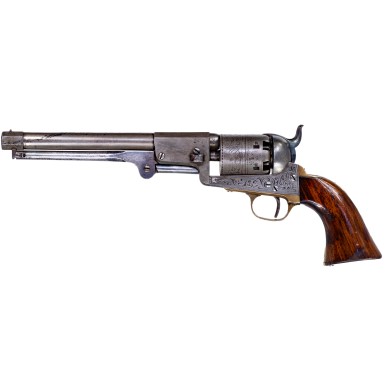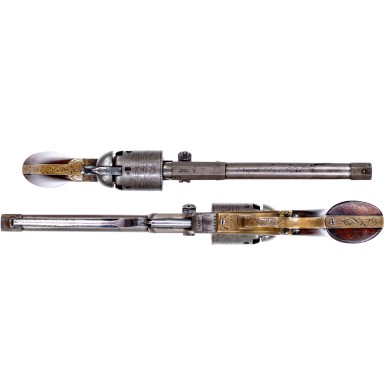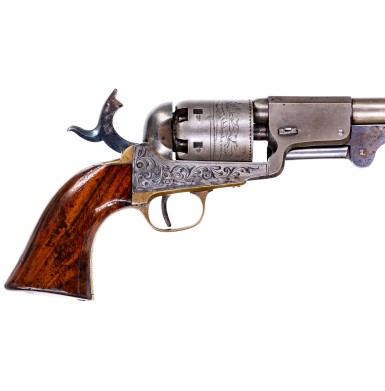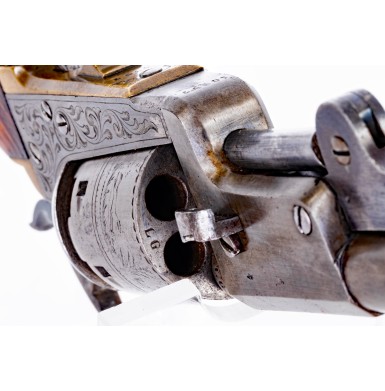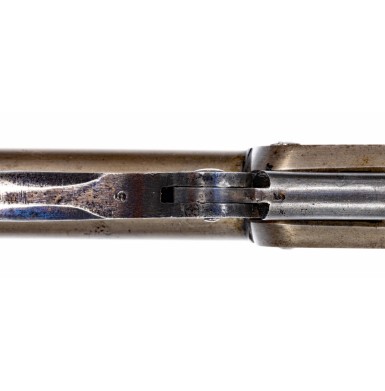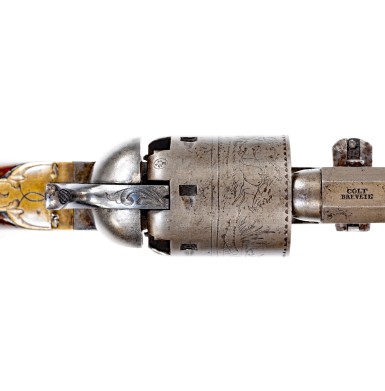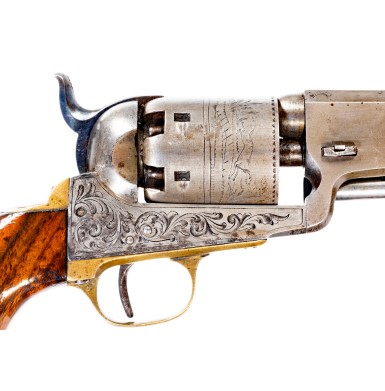Attractive Belgian Brevete Colt Navy By JA Petry of Liège
- Product Code: FHG-C282
- Availability: Out Of Stock
-
$0.00
1848 was the first year when Samuel Colt claimed that his patents, designs and his Hartford manufactory all coalesced into a profitable enterprise. His journey to this stage of his life had been fraught with mishaps, economic reversals and the failure of his original Patent Arms Manufacturing Company. However, by 1848, Colt was well on his way to becoming the “American Legend” as some arms historians have referred to him.
1848 was also a year of civil unrest in Europe, as young people around the world looked to the American model of government and began to agitate for the end to the oppressive regimes that many of them were living under. For the previous two decades, groups around the world taking the monikers of “Young Italy”, “Young Ireland” and “Young Germany” to name just a few, had been organizing to help establish new democratic governments in their countries. Even the United States had its own “Young America” movement that supported the democratic movements around the world and further supported the concept of Manifest Destiny for the United States in North America, and potentially extending to Central and South America. In 1848, much of the European agitation erupted into armed rebellion. This started in France in February of 1848 and quickly spread to Sicily, the Italian States, the Austrian and Hungarian Empires, the Netherlands and many of the member states of the German Confederation. In all, some fifty European countries would become embroiled in this civil unrest that would be called the “Spring of Nations” the “Springtime of the Peoples” and the “Year of Rebellion”. In this chaotic situation, Samuel Colt saw a business opportunity. Despite the fact that his business was just starting to be truly successful in the United States and that American competitors were starting to violate his patents; Colt saw the European upheaval as a chance to enter a new market.
In the late 1830s Colt had visited England and Europe to secure patent protections for designs, with mixed results. Now, with Europe on fire he turned his gaze again across the Atlantic to secure patent protection for his newest products and to sell his revolvers to those willing to pay for them. As he would show in the months leading up to the American Civil War, as well as for some after the firing on Fort Sumter, Colt was interested in sales of his firearms, not in politics or ideology. He cared little if his customers were the oppressors or the oppressed, the rebels or the ruling regime. He simply wanted to sell guns.
However, Colt acted too slowly and by the time he embarked for Europe on May 2, 1849, aboard the steamer Europa, the rebellions had largely fizzled out. While some reforms were secured by the protestors, like the abolition of serfdom in Austria and Hungry, the abolishment of absolute monarchy in Denmark and establishment of a representative democratic government in the Netherlands, much of Europe returned to the previous status quo of monarchial rule. Despite the opportunities he may have missed for immediate sales, Colt continued on his course of securing European patents where he could. Always looking to the future, Colt knew that patent protection would help to prevent the manufacturers in those countries where he could obtain the patents from producing arms based on his designs without paying royalties to Colt. But the patents did more than that. They also helped to protect his “brand” as low quality; poorly built, unlicensed copies of his guns would hurt his reputation. The average person would not necessarily know that they had not purchased a real Colt firearm, and their bad experiences with sub-standard copies would create substantial ill-will for his real products.
During the 1849 excursion Colt did arrange a licensing agreement in Austria, which granted Joseph Ganahl of Innsbruck, Austria the exclusive rights to manufacture Colt patent revolvers for five years, through August of 1854. Ganahl was one of the handful of Austrian manufacturers who held a royal appointment allowing him to manufacture firearms. Ganahl’s company was the Kaiserlich-Koeniglich Privilegierten Maschinen und Spinnen Fabrik, abbreviated as the KKP and translated as the Imperial & Royal Privileged Machinery, Textile and Spinning Factory. During the next few years Ganahl would produce his own interpretation of the Colt Dragoon, primarily for use by the Austrian Navy.
From an immediate financial standpoint, the Ganahl agreement put cash directly in Colt’s pocket. But his other efforts had longer lasting economic ramifications. In England Colt received British Patent #12668/1849 for his revolver design, with the patent drawings showing one of his early Dragoon design variants that still used the side-mounted loading lever from the latter part of Paterson production. The following year, in March 1850, Colt was granted Belgian Patent #1217 for his revolver design concepts. In both cases, the most important salient features that were protected was the actuation of cylinder rotation by the cocking of the hammer, which also activated the bolt stop and locked the cylinder in place. 1850 was a busy year for Colt as he was now actively protecting his rights around the world, both via lawsuits in America and by securing patents around the globe.
It was 1851, the year of the Great Exhibition (often referred to as the Crystal Palace Exhibition) in London, that made Colt a world-renowned name. The success of the arms that he displayed was reported in newspapers in England, Europe and America and likely in all corners of the globe. Some enterprising Belgian gun makers even displayed Colt “Brevete” revolvers. “Brevete” was the French word for “Patented”. One of the most popular guns displayed by Colt was his new belt model revolver which the world would come to know as the Colt Model 1851 Navy. This gun would become one of the most successful of the Colt percussion revolver designs, second only to the 1849 Pocket Model, in terms of length of production and numbers produced. This would be the gun that would become most popular with the Belgian makers who would produce copies of Colt revolvers for the next few decades, both licensed legal guns and illegally produced unlicensed counterfeits.
In an attempt to control the flow of legally and illegally made “Colt” revolvers from the numerous arms makers of Liège, a Belgian representative was engaged by Colt to monitor the flow of arms through the Liège proof house. M Devos Sera was responsible for inspecting the revolvers that were flowing through the proof house and collecting a 10-franc royalty from those that utilized Colt’s protected designs and were also up to the standards of Colt production. As noted, Colt had a vested interest in making sure that any guns produced under his patents be quality arms. It was Mr. Sera’s job to collect the royalties from the guns that passed his quality control inspections, and he was legally able to confiscate those that were made without a license if the guns were not good enough or if the maker refused to pay the royalty. After acceptance, and royalty payment, Sera was to mark the barrels of the guns with a two-line stamp that either read COLT / BREVETE or COLT / PATENT. It is believed that the ones marked “Brevete” were for sale in Europe while the ones marked “Patent” were destined for English speaking countries.
The study of the Belgian-made Colt “Brevete” revolvers is a confusing and complicated web of makers, suppliers and guns that range from poor quality, illegally made copies to licensed products that were of nearly the same high quality as Colt’s Hartford-made guns themselves. The most in-depth study to date was undertaken by Ron Paxton & Roy Marcot in their book Colt Brevete Revolvers, which I have relied upon heavily in writing the background information on the Colt Brevete. The authors note that despite their years of research and examination of numerous extant examples, there still remains much about these arms and their production that is unknown and may never be known.
A number of major Liège makers produced quality, legal copies of Colt revolvers, including N. Gilon, P.J. Fagard, L. Ghaye, J.A. Petry and Auguste Francotte. Sometimes these guns are marked by their makers in obvious ways, like the N. Gilson’s name on the barrel or face of the cylinder or P.J. Fagard’s name inside the triggerguard. More often the markings are less obvious, if they are present at all. Sometimes only initials are present and sometimes no marks are present at all. The presence of absence of the marks does not necessarily help a collector to determine who actually made the gun, or if the maker produced all of the parts in the gun themselves. Much like the English gun trade in Birmingham, the Liège gun trade was in many cases a cottage industry that relied upon many small makers and suppliers to feed parts and fully assembled arms to larger makers. While some very large makers like Francotte operated in a more traditional “factory” setting, many more were small makers working on a piece-work basis. That meant that specialized craftsmen were producing various parts which were then gathered and assembled by other small makers or even the largest makers. To further muddy the waters, Colt soon realized that he could provide Hartford-made parts to the Liège trade and could make money both by collecting royalties and by selling gun parts. Major Hartford-made components that appear from time to time in Liège-made Brevete revolvers include barrels, frames and cylinders. The cylinders are of interest as they are the only ones that appear in Colt Navy Brevete revolvers with the real Ormsby engraved Naval Engagement scene. Other Brevete 1851 Navy revolvers have a wide variety of cylinder scenes, with Paxton & Marcot depicting ten known variations. They also note that these scenes were hand engraved rather than roll engraved as were the Colt scenes, which means even within the basic design there is great variation.
Offered here is very attractive example of a Licensed Colt Brevete Model 1851 Navy Revolver produced by J Auguste Petry of Liège. J.A. Petry worked as a gunmaker in Liege circa 1842-1867 (Stockel). He was one of a consortium of seven Liege-based gunmakers with whom Samuel Colt met and arranged a manufacturing license agreement with in 1853 (Marcot). Petry not only produced guns under license from Colt but also assembled "Colts" using Colt produced parts. This particular gun represents Petry’s take on the Colt Navy revolver and features a somewhat unique octagon to round to octagon barrel and a very “European” grip angle and overall silhouette. The revolver is nominally 9mm rather than the more traditional “.36 caliber” of the Colt version and the stamped marking on the top of the first octagonal portion of the barrel suggests it was very much intended for the European market as it is marked COLT/BREVETE in two lines rather than COLT/PATENT. As noted, researchers believe that this marking may indicates that the gun was intended for sale in Europe rather than an English-speaking country. Like most Belgian brevete Colt’s there are not a lot of markings present on the gun, but unlike so many of the Liège makers there is no need to guess who produced the gun as the top of the round section of the barrel is clearly engraved:
J Auguste Petry a Liege
The matching serial number 10997 is stamped on the bottom of the triggerguard, on the frame and on the bottom of the barrel web. The revolver’s butt is stamped 12 and the rear face of cylinder is stamped A5, with the rear face of barrel web stamped 5. The bottom of the loading lever and plunger are also marked 5, suggesting that this was the primary assembly number for this non-interchangeable parts revolver. The face of cylinder stamped LG and the left edge of forcing cone is stamped LG as well. A small {CROWN}/V controllers mark is stamped on the left side of the barrel web above the wedge and the cylinder has a typical Liège */E/LG in an oval proof. The cylinder is engraved with a scene of hounds on the hunt, while the frame is neatly engraved with flowing foliate Arabesque scrolls. The backstrap, triggerguard bow, butt and top of the hammer spur are engraved ensuite.
While the revolver is clearly “Colt Navy” inspired in basic size and design, it is Petry’s Belgian interpretation of that design. The 7 5/8” long barrel has a large web and initial octagonal section more akin to a Colt Dragoon than a Colt Navy and the round section of the barrel is only 4 ½” in length, terminating in a ¾” long octagonal section at the muzzle. As noted, the grip angle and overall silhouette of the revolver is more akin to other European guns from the 3rdquarter of the 19th century than a traditional Colt revolver. The hammer spur is somewhat blockier and more upright than a Colt spur and slightly shorter. The loading lever is also heavier and blockier than a Colt loading lever, particularly in the web area where it mates with the plunger. Like many Colts of the era the gun uses a brass backstrap and triggerguard/frontstrap which were silver plated. The smooth one-piece grip is of varnished figured European walnut. In traditional Colt fashion the rudimentary sights are a hammer nose notch for the rear sight and a brass cone for the front sight.
The revolver remains in about VERY GOOD condition and is very crips but retains essentially none of its original finish. The metal has a dull, smoky gray patina with some subtle darker mottling on the frame, suggesting that it may have been color casehardened like a Colt with the barrel blued. Some traces of bluish color are present on the loading lever at the juncture with the web and the hammer retains some strong traces of fire blue on its side. The brass retains some minute traces of thin, tarnished silver in protected areas. The markings and engraving remain mostly clear and crisp and the hunt scene on the cylinder is mostly intact. The metal is mostly smooth with some pinpricking around the muzzle, the expected flash erosion in the nipple recesses of the cylinder and on its face and some very lightly scattered pitting here and there. There is on streaked line of etched pitting on the left side of the barrel, running from the muzzle up into the maker’s name on the barrel that is probably the result of poor storage. The cones (nipples) all appear to be original and remain fairly crisp, showing only light to moderate use. The safety pins on the rear face of the cylinder are all still intact and mostly in very good to fine condition with only a couple showing any real battering or serious wear. The hammer spur shows a minor hairline forging flaw that is not particularly noticeable but which is mentioned for exactness in the description. The revolver is in fine mechanical condition and remains extremely tight. The revolver times, indexes and locks up exactly as it should. The loading lever operates smoothly as well and locks securely into place when it is not in use. The bore is in VERY GOOD condition and remains partly bright with moderate amounts of scattered oxidation and some pitting. The bore retains very crisp and deep 7-groove rifling with a fairly fast right-hand twist. The one-piece walnut grip is in about FINE condition and retains much of its original finish. The grip is solid and free of any breaks, cracks or repairs and remains fairly crisp. The grip shows only some very scattered bumps, dings and handling marks, and a minor chip missing for the sharp leading edge on the lower left side.
Overall, this is a very nice and attractive example of a relatively scarce and very interesting Liège-made Colt Model 1851 Navy Brevete Revolver by J. Auguste Petry. Although not really retaining any finish, the gun is still very crisp, quite attractive, and 100% complete, correct and original in all respects. This would be a fine addition to any collection of Brevete revolvers or to an advanced Colt collection. It is a really lovely gun that you will certainly be very proud to display in your collection.
Tags: Attractive, Belgian, Brevete, Colt, Navy, By, JA, Petry, of, Liege



